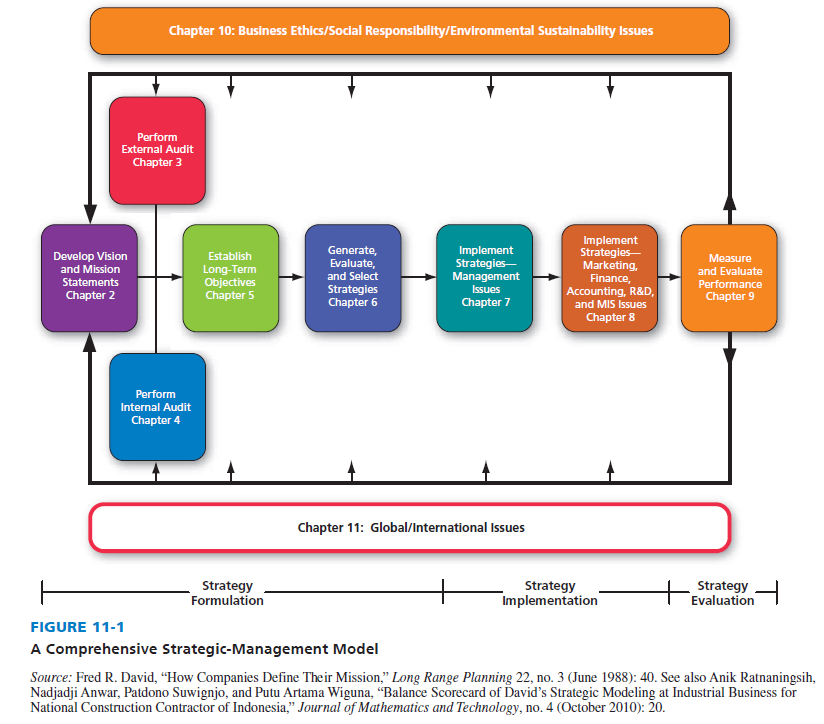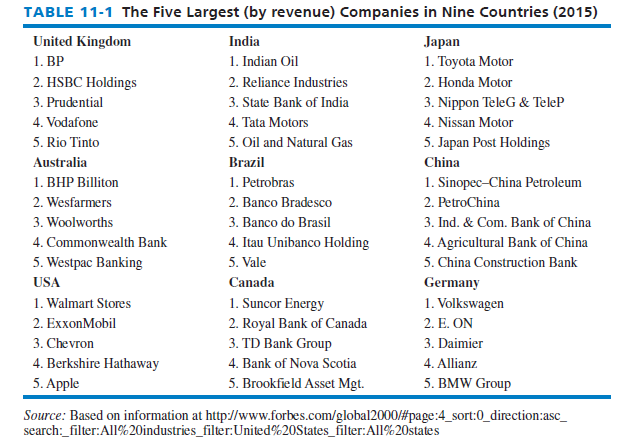Exports of goods and services from the United States account for only 13.5 percent of U.S. gross domestic product, so the nation is still largely a domestic, continental economy. What happens inside the United States largely determines the strength of the economic recovery. In contrast, as a percent of gross domestic product (GDP), exports comprise 45.6 percent of the German economy, 22.6 percent of the Chinese economy, and 187 percent of the Singapore economy (http://data.worldbank.org/indicator/NE.EXP.GNFS.ZS). Singapore’s number is so high because it imports oil and other products and then re-exports them globally. A point here is that the United States has substantial room for improvement in doing business globally based on the 11 percent exports to the GDP number.

A world market has emerged from what previously was a multitude of distinct national markets, and the climate for international business today is more favorable than in years past. Mass communication and high technology have created similar patterns of consumption in diverse cultures worldwide. This means that many companies may find it difficult to survive by relying solely on domestic markets.
Globalization is a process of doing business worldwide, so strategic decisions are made based on global profitability of the firm rather than just domestic considerations. A global strategy seeks to meet the needs of customers worldwide, with the highest value at the lowest cost. This may mean locating production in countries with the lowest labor costs or abundant natural resources, locating research and complex engineering centers where skilled scientists and engineers can be found, and locating marketing activities close to the markets to be served.
A global strategy includes designing, producing, and marketing products with global needs in mind, instead of considering individual countries alone. A global strategy integrates actions against competitors into a worldwide plan. Today, there are global buyers and sellers and the instant transmission of money and information across continents.

It is no exaggeration that in any industry that is, or is rapidly becoming, global, the riskiest possible posture is to remain a domestic competitor. The domestic competitor will watch as more aggressive companies use this growth to capture economies of scale and learning. The domestic competitor will then be faced with an attack on domestic markets using different (and possibly superior) technology, product design, manufacturing, marketing approaches, and economies of scale.1 As a point of global reference, the five largest companies in nine different countries are listed in Table 11-1.
1. Multinational Firms
Organizations that conduct business operations across national borders are called international firms or multinational corporations. The strategic-management process is conceptually the same for multinational firms as for purely domestic firms; however, the process is more complex for international firms as a result of more variables and relationships. The social, cultural, demographic, environmental, political, governmental, legal, technological, and competitive opportunities and threats that face a multinational corporation are almost limitless, and the number and complexity of these factors increase dramatically with the number of products produced and the number of geographic areas served. Millions of small businesses do business everyday outside their home country by interacting with customers though websites, smartphones, and social media. All of Africa, and places such as Cuba and Iran, are becoming more desirable for business every day.
More time and effort are required to identify and evaluate external trends and events in multinational corporations than in domestic corporations. Geographic distance, cultural and national differences, and variations in business practices often make communication between domestic headquarters and overseas operations difficult. Strategy implementation can be more difficult because different cultures have different norms, values, and work ethics. Multinational corporations (MNCs) face unique and diverse risks, such as expropriation of assets, currency losses through exchange rate fluctuations, unfavorable foreign court interpretations of contracts and agreements, social/political disturbances, import/export restrictions, tariffs, and trade barriers. Strategists in MNCs are often confronted with the need to be globally competitive and nationally
responsive at the same time. With the rise in world commerce, government and regulatory bodies are more closely monitoring foreign business practices. The U.S. Foreign Corrupt Practices Act, for example, monitors business practices in many areas.
Before entering international markets, firms should scan relevant journals and patent reports, seek the advice of academic and research organizations, participate in international trade fairs, form partnerships, and conduct extensive research to broaden their contacts and diminish the risk of doing business in new markets. Firms can also offset some risks of doing business internationally by obtaining insurance from the U.S. government’s Overseas Private Investment Corporation (OPIC). The decision to expand operations into foreign markets—that is, to globalize—is one of the most important strategic decisions made by companies. Thus, variables that influence how, when, where, and why to internationalize have attracted much attention in scholarly journals. Recent research reveals that countries are attractive not only because of their own institutions but also as a function of their serving as a platform for entry into other regions.2 Therefore, multinational firms make globalization decisions with special consideration in mind for how a particular region/country will facilitate the firm’s further globalization into other regions/countries.
2. Different Languages Globally
A strategic issue facing many firms is whether to publish their website material in different languages, given that most of the world’s population does not speak English. Pioneering work to document the number of different languages spoken has been done by the Summer Institute of Linguistics (SIL) International. That organization today publishes 2,508 translations of the Christian Bible, and has compiled a catalogue of the world’s languages, called the Ethnologue, which lists 6,909 distinct languages being spoken. Of that total, only 230 are spoken in Europe and 2,197 in Asia. But in Papua, New Guinea, 830 different languages are spoken by 3.9 million people, and in France, the Ethnologue cites 10 languages being spoken, including Picard, Gascon, Provencal, Allemannisch, Alsace, Breton, and French. Academic Research Capsule 11-1 reveals that most languages will permanently disappear by the end of this century.
3. Labor Unions across Europe
Prevalence of unions is a relevant factor in many strategic decisions, such as where to locate stores or factories. There is great variation across Europe in regards to levels of union membership, ranging from 74 percent of employees in Finland and 71 percent in Sweden to 9 percent in Lithuania and 8 percent in France. However, percentage of union membership is not the only indicator of strength. In France, for example, unions have repeatedly shown that despite low levels of membership, they are able to mobilize workers in mass strikes and demonstrations to great effect.
The average level of union membership across the whole of the European Union (EU), weighted by the numbers employed in the different member states, is 23 percent, compared to about 11 percent in the United States. The European average is held down by relatively low levels of membership in some of the larger EU states: Germany with 18 percent, France with 8 percent, Spain with 19 percent, and Poland with 12 percent. The three smallest states—Cyprus, Luxembourg, and Malta—have levels well above the average.
The four Nordic countries of Denmark, Sweden, Finland, and Norway have 67, 70, 74, and 52 percent, respectively, of all employees as members of unions. In part this is because, as in Belgium, which also has above-average levels of union density, unemployment and other social benefits are normally paid out through the union. High union density in the Nordic countries also reflects an approach that sees union membership as a natural part of employment. Central and Eastern Europe nations generally have below-average levels of union membership. In Poland, for example, 12 percent of employees are estimated to be union members. Level of union membership is clearly trending downward all over Europe. The two exceptions appear to be Ireland and Italy, where union membership is slowly growing.
4. How Many Languages Are There Globally?
When businesses consider offering their products or services globally, or manufacturing and securing resources outside their own country, language barriers arise. Interacting with people who speak a different language is one of many variables that complicate doing business globally—yet millions of businesses need to do more business globally. Thankfully, translations to and from most mainstream languages such as English, Spanish, French, German, and Chinese are easily done with online programs, and there are millions of multilingual people.
The implication for businesses doing business globally is that the total number of languages spoken globally is decreasing quite dramatically. For example, in North America, many Native American languages are disappearing yearly, a common phenomenon all over the world. Whenever any language ceases to be learned by young children, that language generally does not survive the death of current native speakers. In North America, about 75 languages are spoken by only a handful of older people, and those languages are expected to become extinct. About 25 percent of the world’s languages have fewer than a thousand remaining speakers. By the year 2099, analysts estimate that roughly one half of the 6,909 languages listed by Ethnologue will disappear. By 2115, researchers say there will be only 600 left on the planet.
Source: Based on information from the website http://www.linguisticsociety. org/content/how-many-languages-are-there-world; and John McWhorter, “What the World Will Speak in 2115,” Wall Street Journal, January 4, 2015, C1-C2.
Source: David Fred, David Forest (2016), Strategic Management: A Competitive Advantage Approach, Concepts and Cases, Pearson (16th Edition).

17 May 2021
17 May 2021
17 May 2021
17 May 2021
18 May 2021
17 May 2021